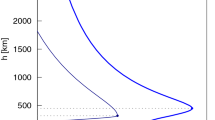Abstract
The majority of navigation satellite receivers operate on a single frequency. They compensate for the ionospheric delay using either an ionospheric model which typically only corrects for 50% of the delay or a thin-shell map of the ionosphere. A 4D tomographic imaging technique is used to map the free electron density over the full-height of the ionosphere above North America during autumn 2003. The navigation solutions computed using correction based upon the thin-shell and the full-height maps are compared in this paper. The maps are used to calculate the excess propagation delay on the L1 frequency experienced by GPS receivers at selected locations across North America. The excess delay is applied to correct the single-frequency pseudorange observations at each location, and the improvements to the resulting positioning are calculated. It is shown that the thin-shell and full-height maps perform almost as well as a dual-frequency carrier-smoothed benchmark and for most receivers better than the unfiltered dual-frequency benchmark. The full-height corrections perform well and are considerably better than thin-shell corrections under extreme storm conditions.





















Similar content being viewed by others
References
Allain DJ, Mitchell CN (2009) Ionospheric delay corrections for single-frequency GPS receivers over Europe using tomographic mapping. GPS Solut 13(2):141–151. doi:10.1007/s10291-008-0107-y
Ashby N, Spilker JJ (1995) Introduction to relativistic effects on the Global Positioning System. In: Spilker JJ, Parkinson BW (eds) Global Positioning System: theory and applications, vol 1. AIAA, New York, pp 623–697
Bust GS, Mitchell CN (2008) History, current state, and future directions of ionospheric imaging. Rev Geophys 46:1003. doi:10.1029/2006RG000212
Hernández-Pajares M, Juan JM, Sanz J (2000) Application of ionospheric tomography to real-time GPS carrier-phase ambiguities resolution, at scales of 400–1,000 km and with high geomagnetic activity. Geophys Res Lett 27:2009–2012. doi:10.1029/1999GL011239
Klobuchar JA (1987) Ionospheric time-delay algorithm for single-frequency gps users. IEEE Trans Aerosp Electron Syst AES 23(3):325–331
Klobuchar JA (1996) Ionospheric effects on GPS. In: Spilker JJ, Parkinson BW (eds) Global Positioning System: theory and applications, vol 1. AIAA, New York, pp 485–515
Komjathy A, Sparks L, Mannucci AJ, Coster A (2005) The ionospheric impact of the October 2003 storm event on wide area augmentation system. GPS Solut 9(1):41–50. doi:10.1007/s10291-004-0126-2
Mannucci A, Iijima B, Lindqwister U, Pi X, Sparks L, Wilson B (1999) GPS and ionosphere. In: Stone WR (ed) Review of radio science 1996–1999. Oxford University Press, Oxford, pp 625–665
Meggs RW, Mitchell CN (2006) A study into the errors in vertical total electron content mapping using GPS data. Radio Sci 41:1008. doi:10.1029/2005RS003308
Mitchell CN, Spencer PSJ (2003) A three dimensional time-dependent algorithm for ionospheric imaging using GPS. Ann Geophys 46(4):687–696
Smith DA, Araujo-Pradere EA, Minter C, Fuller-Rowell T (2008) A comprehensive evaluation of the errors inherent in the use of a two-dimensional shell for modeling the ionosphere. Radio Sci 43:6008. doi:10.1029/2007RS003769
Spencer PSJ, Mitchell CN (2007) Imaging of fast moving electron-density structures in the polar cap. Ann Geophys 50(3):427–434
Spilker JJ (1994) Tropospheric effects on GPS. In: Spilker JJ, Parkinson BW (eds) Global Positioning System: theory and applications, vol 1. AIAA, New York, pp 517–546
Acknowledgments
This project was funded by the EPSRC. We are grateful to the International GNSS Service (IGS) for the GPS observation data and for the GPS precise ephemeris. We acknowledge the use of data provided by the UNAVCO Facility with support from the National Science Foundation and NASA under NSF Cooperative Agreement No. EAR-0735156. We acknowledge the use of National Geophysical Data Center (NGDC) coastline data. We acknowledge the participation of Andrew Brown of the University of Southampton.
Author information
Authors and Affiliations
Corresponding author
Rights and permissions
About this article
Cite this article
Allain, D.J., Mitchell, C.N. Comparison of 4D tomographic mapping versus thin-shell approximation for ionospheric delay corrections for single-frequency GPS receivers over North America. GPS Solut 14, 279–291 (2010). https://doi.org/10.1007/s10291-009-0153-0
Received:
Accepted:
Published:
Issue Date:
DOI: https://doi.org/10.1007/s10291-009-0153-0




